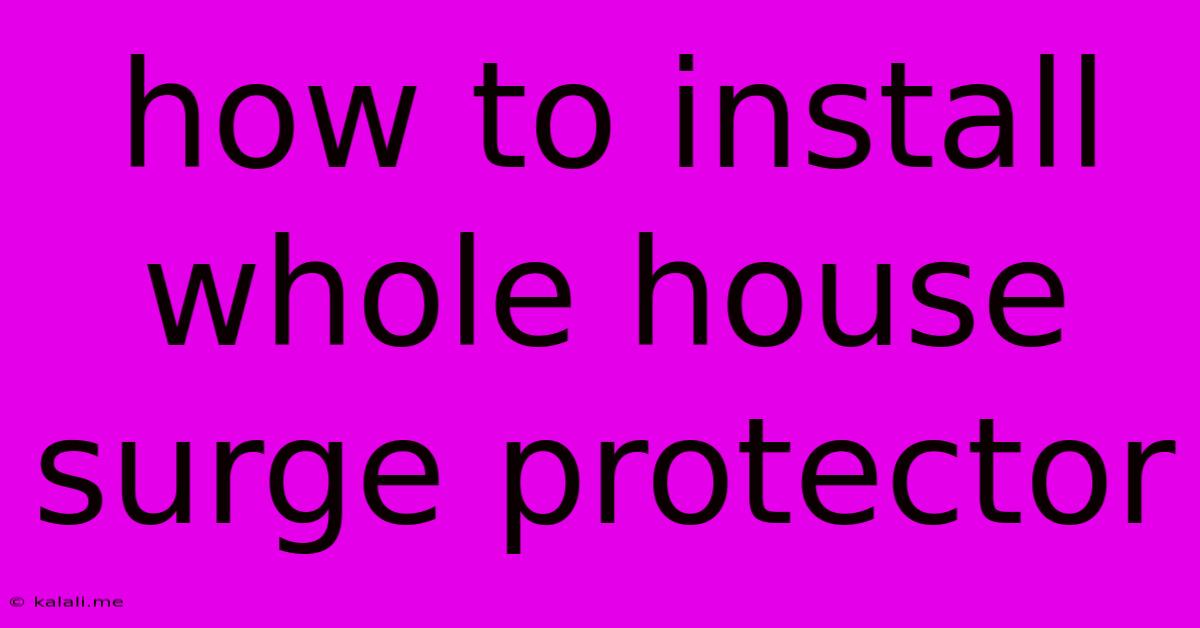How To Install Whole House Surge Protector
Kalali
Jun 02, 2025 · 3 min read

Table of Contents
How to Install a Whole-House Surge Protector: Protecting Your Investment
A power surge can wreak havoc on your home's electronics, appliances, and even wiring. Protecting your investment with a whole-house surge protector is a smart move, significantly reducing the risk of costly repairs or replacements. While professional installation is always recommended, understanding the basic process can empower you to make informed decisions. This guide outlines the steps involved, emphasizing the importance of safety and professional expertise. This is not a DIY guide for inexperienced individuals; improper installation can be dangerous.
Why Install a Whole-House Surge Protector?
Power surges, caused by lightning strikes, electrical grid problems, or even nearby construction, can send a dangerous spike of voltage through your home's electrical system. This surge can damage anything plugged into the outlets, as well as internal components of appliances and electronics. A whole-house surge protector acts as a shield, diverting excess voltage to ground, preventing damage to your valuable assets. Consider the peace of mind knowing your expensive electronics, HVAC system, and other appliances are safeguarded.
Understanding the Components
Before diving into the installation, familiarize yourself with the key components:
- Surge Protector Unit: This is the main component, containing the surge-protection devices (SPDs) that absorb excess voltage. It typically has multiple input and output terminals for connection to your electrical panel.
- Electrical Panel: This is the central distribution point for your home's electrical system. The surge protector will be installed within this panel.
- Grounding Rod: Essential for safely diverting excess voltage to the earth.
Step-by-Step Installation (For Professionals Only)
Disclaimer: The following steps are for informational purposes only. This is a complex electrical job and should only be performed by a qualified electrician. Incorrect installation can lead to electrical hazards and void warranties.
- Safety First: Turn off the main breaker to your electrical panel. This is crucial to prevent electrical shock. Verify the power is off using a non-contact voltage tester.
- Access the Electrical Panel: Carefully remove the panel cover, ensuring you have adequate lighting and workspace.
- Locate the Main Electrical Feed: Identify the main electrical feed entering your panel.
- Connect the Surge Protector: Connect the surge protector's input terminals to the main electrical feed. Follow the manufacturer's instructions precisely – this usually involves attaching wires securely using appropriate connectors.
- Connect the Grounding Wire: Connect the grounding wire from the surge protector to the appropriate grounding point in your electrical panel. This is crucial for diverting the surge safely.
- Connect the Output Terminals: Connect the output terminals of the surge protector to the main bus bars of your electrical panel. This ensures power continues to flow to your home.
- Secure the Surge Protector: Securely mount the surge protector within the electrical panel.
- Inspect the Connections: Thoroughly inspect all connections to ensure they are tight and secure.
- Restore Power: Carefully turn the main breaker back on.
- Test the Installation: Use a specialized surge protector tester to verify that the unit is properly installed and functioning.
Choosing the Right Surge Protector
Several factors influence the selection of a whole-house surge protector:
- Joule Rating: This indicates the amount of surge energy the unit can absorb. Higher joule ratings offer greater protection.
- Clamping Voltage: This represents the maximum voltage allowed to pass through to your home's electrical system. Lower clamping voltages offer better protection.
- Warranty: A good warranty indicates the manufacturer's confidence in their product's quality.
Maintenance and Monitoring
While whole-house surge protectors require minimal maintenance, it's advisable to have them inspected regularly by a qualified electrician. They may also incorporate indicators that alert you to potential issues or the need for replacement.
Conclusion
Installing a whole-house surge protector is a worthwhile investment for protecting your home's electronics and appliances. While this guide outlines the process, it's crucial to emphasize the importance of hiring a qualified electrician for installation. Their expertise ensures a safe and effective installation, maximizing the protection offered by your new surge protector. Don't risk your safety or your valuable assets – seek professional assistance.
Latest Posts
Latest Posts
-
What Is It Called When The Drumsticks Hit The Sides
Jun 04, 2025
-
Cockroach On Its Back But Alive
Jun 04, 2025
-
What Length Drywall Screws For 1 2
Jun 04, 2025
-
Life Is Like A Box Of Chocolates Meaning
Jun 04, 2025
-
Do You Insulate Basement Walls Before Framing
Jun 04, 2025
Related Post
Thank you for visiting our website which covers about How To Install Whole House Surge Protector . We hope the information provided has been useful to you. Feel free to contact us if you have any questions or need further assistance. See you next time and don't miss to bookmark.